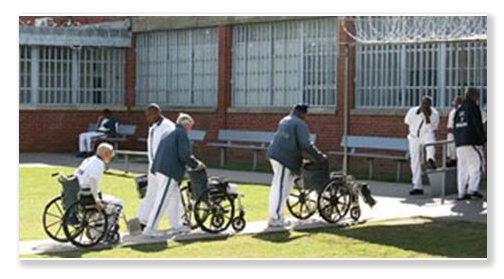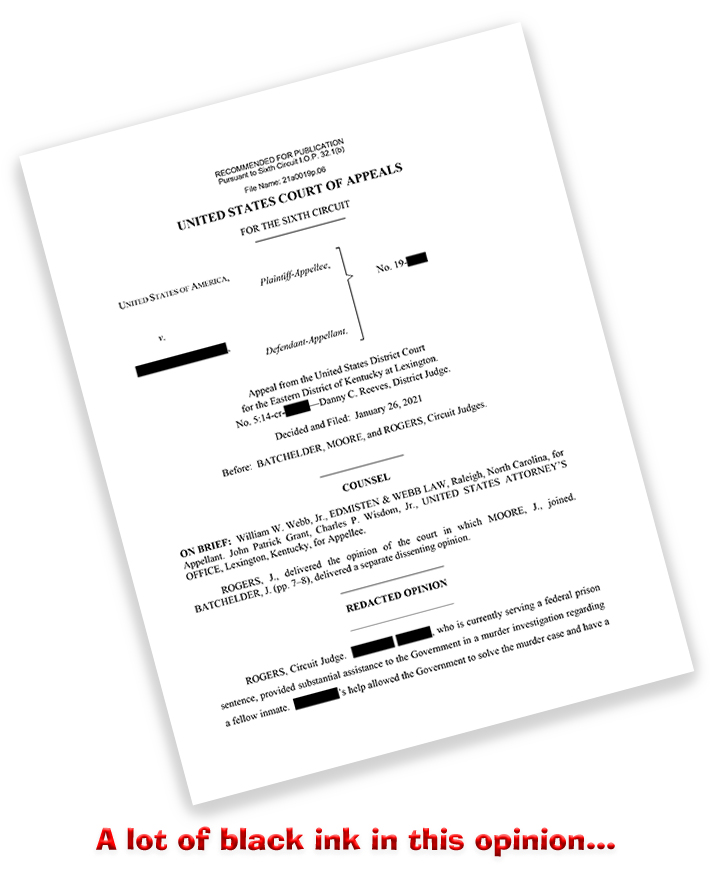We post news and comment on federal criminal justice issues, focused primarily on trial and post-conviction matters, legislative initiatives, and sentencing issues.

A COUPLE OF COVID MIRACLES… OTHERWISE, A BAD WEEK FOR THE BOP
Despite what was a pretty bad run last week, PR-wise, for the Federal Bureau of Prisons, we were privileged to witness a couple of miracles of Biblical proportion.

First, the numbers: The BOP continues to write down the COVID-19 inmate totals. As of last Friday, the BOP reported 2,273 sick inmates, down 43% from the week before. Curiously, the agency reports 1,729 sick staffers, a mere 3% reduction from the week before. Cynics might say that when you control the patients, you can say when they’re recovered and when they’re not. Controlling employees who go home at the end of each shift… not so easy,
At the end of the week, the BOP reported 229 federal prisoner deaths, an increase of five. The BOP says it has tested 68% of all inmates at least once, with a whopping 44.6% testing positive for COVID.
 Now for the miracles: Three federal prisoners housed in private prisons have miraculously come back to life, at least on paper. Last Tuesday, the total number of inmate deaths in the private prisons dropped from 16 to 13 without explanation. The private operators, who are losing their federal contracts, seem to know something about how to cure people of COVID. Or perhaps they’ve taken the story of Lazarus to heart.
Now for the miracles: Three federal prisoners housed in private prisons have miraculously come back to life, at least on paper. Last Tuesday, the total number of inmate deaths in the private prisons dropped from 16 to 13 without explanation. The private operators, who are losing their federal contracts, seem to know something about how to cure people of COVID. Or perhaps they’ve taken the story of Lazarus to heart.
Meanwhile, the BOP is starting to provide vaccination information on its website, and – speaking of miracles – as of last Friday, the BOP was reporting that it had received 36,650 doses of vaccine, but somehow administered 2,638 more doses than it had received. The New Testament records that Jesus fed 5,000 people with five loaves and two fishes, and had more left over than he started with. The BOP has apparently replicated that miracle.
The BOP’s detailed vaccination information is woefully incomplete. In its facility-by-facility data, the number of inoculations accounts for only a third of the doses the BOP says it had distributed. Last Friday’s numbers show 7,468 staff (20.7% of all BOP employees) and 5,751 inmates (3.8% of the population) receiving the vaccine. The data only report that vaccines have been administered in 33% of all locations, which clashes with BOP statements several weeks ago . The New York Daily News said lawyers for defendants at MCC New York told it “the vaccine’s distribution at the jail has been haphazard, with some high-risk prisoners still waiting for shots.”
 Other than the miracles, it was a tough week for the BOP. First, FCI Ft Dix Warden David Ortiz, who presided over a COVID-19 explosion at that facility last fall, suddenly was relieved of duty, reassigned to the BOP Northeast Regional Office. You may recall that the BOP uses desks at its regional offices as “time-out chairs” for wardens and other management people on the outs. Last summer, for example, the BOP sent the FCI Oakdale warden to work on a desk at an office well away from inmates.
Other than the miracles, it was a tough week for the BOP. First, FCI Ft Dix Warden David Ortiz, who presided over a COVID-19 explosion at that facility last fall, suddenly was relieved of duty, reassigned to the BOP Northeast Regional Office. You may recall that the BOP uses desks at its regional offices as “time-out chairs” for wardens and other management people on the outs. Last summer, for example, the BOP sent the FCI Oakdale warden to work on a desk at an office well away from inmates.
Ortiz was “temporarily” replaced by Lamine N’Diaye, the former warden at the MCC New York, who himself was placed on desk duty at the Northeast Regional Office in 2019 while authorities investigation the death of millionaire sex offender Jeffrey Epstein. At the time, Jose Rojas, a BOP union leader and teacher at FCI Coleman, said N’Diaye should be home without pay instead of being reassigned. “I put this on the warden,” he said. “If he would have had common sense and followed policy, we wouldn’t be here discussing this.”
In Chicago, inmates filed a proposed class action suit against the BOP for conditions at MCC Chicago. The suit, Price v. Federal Bureau of Prisons, Case No 1:21-cv-00542, claims the high-rise jail’s “haphazard and insufficient” measures to contain the coronavirus pandemic led to two major outbreaks, endangering people in custody and staff. The suit alleges a lack of cleaning supplies and proper social distancing as well as a “poorly implemented and incomplete” isolation and quarantine process. Officials also allegedly turned “a blind eye” to staff who didn’t wear masks and ignored some people in custody who asked for tests.
As a result, almost 300 MCC Chicago inmates have tested positive for COVID-19, although the lawsuit claims that “the real infection rate was certainly higher” than that.
 BOP correctional officers at FCI Mendota sued the BOP in the Federal Court of Claims last week for an extra 25% in pay for the hours they’ve worked during the COVID-19 pandemic. Aaron McGlothin, an FCI Mendota employees union leader, said COs feel particularly strongly about the need for hazard pay because they believe the Bureau of Prisons has not taken the proper precautions to protect them.
BOP correctional officers at FCI Mendota sued the BOP in the Federal Court of Claims last week for an extra 25% in pay for the hours they’ve worked during the COVID-19 pandemic. Aaron McGlothin, an FCI Mendota employees union leader, said COs feel particularly strongly about the need for hazard pay because they believe the Bureau of Prisons has not taken the proper precautions to protect them.
“At some point you have to say enough is enough, you have to do what you have to do, and seek outside assistance,” McGlothin said. “If our agency took the proper precautions, we wouldn’t have to deal with this the way we have, and they owe us.”
The Associated Press last week reported that records it obtained showed that the BOP’s string of executions at FCI Terre Haute last December and January “likely acted as a superspreader events… something health experts warned could happen when the Justice Department insisted on resuming executions during a pandemic. The AP said BOP employees carrying out the executions “had contact with inmates and other people infected with the coronavirus, but were able to refuse testing and declined to participate in contact tracing efforts and were still permitted to return to their work assignments… Other staff members, including those brought in to help with executions, also spread tips to their colleagues about how they could avoid quarantines and skirt public health guidance from the federal government and Indiana health officials.”
 Finally, an arrest: A federal grand jury has returned a three-count indictment charging a former BOP CO, Jimmy Lee Highsmith, with sexually abusing three female prisoners at FCI Tallahassee. Highsmith was arrested last Wednesday night. In fall 2019, Florida Sen. Marco demanded the BOP respond to newspaper reports of sexual abuse of female inmates at Tallahassee and FCI Coleman camp. In fact, Highsmith was identified nine months ago by a former FCI Tallahassee inmate as having raped her.
Finally, an arrest: A federal grand jury has returned a three-count indictment charging a former BOP CO, Jimmy Lee Highsmith, with sexually abusing three female prisoners at FCI Tallahassee. Highsmith was arrested last Wednesday night. In fall 2019, Florida Sen. Marco demanded the BOP respond to newspaper reports of sexual abuse of female inmates at Tallahassee and FCI Coleman camp. In fact, Highsmith was identified nine months ago by a former FCI Tallahassee inmate as having raped her.
There’s a saying among BOP inmates that many of the COs are “only a uniform change away…” Jimmy has become the illustration for that aphorism.
New York Daily News, Ghislaine Maxwell receives COVID-19 vaccine at Brooklyn federal jail: source (February 2, 2021)
NJ.com, Warden at N.J. federal prison reassigned amid massive COVID outbreak (February 2, 2021)
Albany Times-Union, Jail’s warden reassigned (August 14, 2019)
Chicago Sun Times, Inmates file class-action lawsuit over handling of COVID-19 at downtown jail (January 31, 2021)
The Fresno Bee, California prison employees file lawsuit demanding hazard pay during COVID pandemic (February 5, 2021)
Associated Press, Records show 13 federal executions under Trump administration at Indiana prison likely acted as COVID-19 superspreader (February 5, 2021)
Associated Press, Former corrections officer accused of sexually abusing multiple inmates at Federal Correctional Institution in Tallahassee (February 4, 2021)
– Thomas L. Root


 What other business responds to a loss of customers by hiring more staff?
What other business responds to a loss of customers by hiring more staff? Last November’s IG report noted that from 2000 to 2016, the BOP’s per capita cost of incarceration increased from about $22,000 to nearly $35,000 per inmate. “Consequently,” the IG said, “even though the BOP inmate population has declined by 29% from 2013 to 2020 to a current total of approximately 155,000 total inmates, the BOP continues to account for fully 24% of the Department’s total budget request in 2020.”
Last November’s IG report noted that from 2000 to 2016, the BOP’s per capita cost of incarceration increased from about $22,000 to nearly $35,000 per inmate. “Consequently,” the IG said, “even though the BOP inmate population has declined by 29% from 2013 to 2020 to a current total of approximately 155,000 total inmates, the BOP continues to account for fully 24% of the Department’s total budget request in 2020.”



























